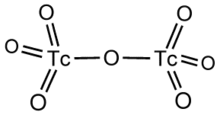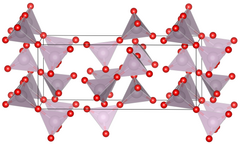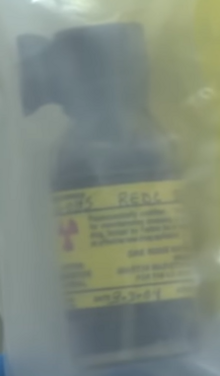| Revision as of 17:07, 26 May 2024 editAnDeargMor (talk | contribs)Extended confirmed users798 edits Changed to covalent model as mekting and boiling points are low← Previous edit | Latest revision as of 15:18, 16 July 2024 edit undo0x16w (talk | contribs)Extended confirmed users940 edits Added an image | ||
| Line 44: | Line 44: | ||
| }} | }} | ||
| }} | }} | ||
| ]|Technetium (VII) oxide containing ]]] | |||
| '''Technetium(VII) oxide''' is the ] with the ] Tc<sub>2</sub>O<sub>7</sub>. This yellow volatile solid is a rare example of a molecular binary metal oxide, the other examples being ], ], and the unstable ]. It adopts a ] corner-shared bi-tetrahedral structure in which the terminal and bridging Tc−O bonds are 167pm and 184 pm respectively and the Tc−O−Tc angle is 180°.<ref>{{cite journal|last=Krebs|first=Bernt|title = Technetium(VII)-oxid: Ein Übergangsmetalloxid mit Molekülstruktur im festen Zustand| journal = Angewandte Chemie | year = 1969 | volume = 81| issue = 9| pages = 328–329| doi = 10.1002/ange.19690810905|bibcode=1969AngCh..81..328K}}</ref> | '''Technetium(VII) oxide''' is the ] with the ] Tc<sub>2</sub>O<sub>7</sub>. This yellow volatile solid is a rare example of a molecular binary metal oxide, the other examples being ], ], and the unstable ]. It adopts a ] corner-shared bi-tetrahedral structure in which the terminal and bridging Tc−O bonds are 167pm and 184 pm respectively and the Tc−O−Tc angle is 180°.<ref>{{cite journal|last=Krebs|first=Bernt|title = Technetium(VII)-oxid: Ein Übergangsmetalloxid mit Molekülstruktur im festen Zustand| journal = Angewandte Chemie | year = 1969 | volume = 81| issue = 9| pages = 328–329| doi = 10.1002/ange.19690810905|bibcode=1969AngCh..81..328K}}</ref> | ||
Latest revision as of 15:18, 16 July 2024
 Structural formula of technetium(VII) oxide. | |
 Unit cell of technetium(VII) oxide. | |
| Names | |
|---|---|
| IUPAC name Technetium(VII) oxide | |
| Other names Technetium heptoxide | |
| Identifiers | |
| CAS Number | |
| 3D model (JSmol) | |
| PubChem CID | |
| CompTox Dashboard (EPA) | |
InChI
| |
SMILES
| |
| Properties | |
| Chemical formula | Tc2O7 |
| Molar mass | 307.810 g/mol |
| Appearance | light yellow solid |
| Density | 3.5 g/cm |
| Melting point | 119.5 °C (247.1 °F; 392.6 K) |
| Boiling point | 310.6 °C (591.1 °F; 583.8 K) |
| Solubility in water | hydrolysis to HTcO4 |
| Magnetic susceptibility (χ) | −40.0·10 cm/mol |
| Structure | |
| Crystal structure | Primitive orthorhombic |
| Space group | Pbca, No. 61 |
| Lattice constant | a = 1375.6 pm, b = 743.9 pm, c = 561.7 pm |
| Hazards | |
| Occupational safety and health (OHS/OSH): | |
| Main hazards | radioactive |
| Except where otherwise noted, data are given for materials in their standard state (at 25 °C , 100 kPa).
| |

Technetium(VII) oxide is the chemical compound with the formula Tc2O7. This yellow volatile solid is a rare example of a molecular binary metal oxide, the other examples being RuO4, OsO4, and the unstable Mn2O7. It adopts a centrosymmetric corner-shared bi-tetrahedral structure in which the terminal and bridging Tc−O bonds are 167pm and 184 pm respectively and the Tc−O−Tc angle is 180°.
Technetium(VII) oxide is prepared by the oxidation of technetium at 450–500 °C:
- 4 Tc + 7 O2 → 2 Tc2O7
It is the anhydride of pertechnetic acid and the precursor to sodium pertechnetate:
- Tc2O7 + 2 H2O → 2 HTcO4
- Tc2O7 + 2 NaOH → 2 NaTcO4 + H2O
References
- ^ Krebs, Bernt (1971). "Technetium(VII)-oxid: Ein Übergangsmetalloxid mit Molekülstruktur im festen Zustand". Zeitschrift für anorganische und allgemeine Chemie. 380 (2): 146–159. doi:10.1002/zaac.19713800205.
- Krebs, Bernt (1969). "Technetium(VII)-oxid: Ein Übergangsmetalloxid mit Molekülstruktur im festen Zustand". Angewandte Chemie. 81 (9): 328–329. Bibcode:1969AngCh..81..328K. doi:10.1002/ange.19690810905.
- Herrell, A. Y.; Busey, R. H.; Gayer, K. H. (1977). Technetium(VII) Oxide, in Inorganic Syntheses. Vol. XVII. pp. 155–158. doi:10.1002/9780470132487.ch41. ISBN 0-07-044327-0.
| Technetium compounds | |
|---|---|
| Technetium(II) | |
| Technetium(III) | |
| Technetium(IV) | |
| Technetium(V) | |
| Technetium(VI) | |
| Technetium(VII) | |